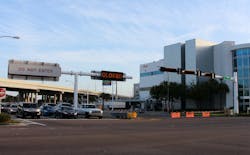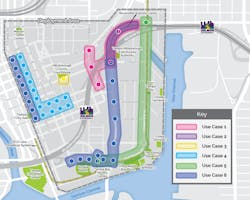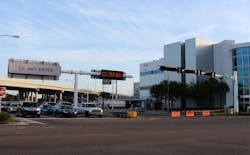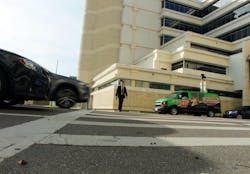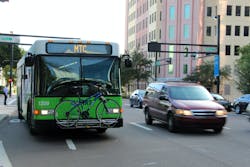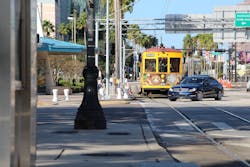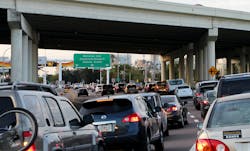Piloting toward the future
The Tampa Hillsborough Expressway Authority (THEA) along with New York City (NYC) and the Wyoming Department of Transportation (WyDOT) were selected by the U.S. DOT to implement, deploy, operate and maintain a connected-vehicle (CV) pilot deployment focusing on vehicle-to-infrastructure (V2I) applications. The three pilots have distinct characteristics: WyDOT is focusing on rural issues and commercial vehicles; NYC is focusing on urban issues and fleet vehicles; and the Tampa, Fla., pilot is focusing on urban issues using primarily private vehicles, as well as buses and streetcars.
THEA owns and operates the Lee Roy Selmon Expressway Reversible Express Lanes (REL), along with several connector surface streets, providing an ideal environment for a CV deployment. The REL corridor has featured emerging technologies intended to solve real-world issues, as evidenced by its conversion to all-electronic tolling, the application of reversible express lanes and being among the first expressways in the state to use image-based tolling—all of which made it ideal to pursue further technological development.
As one of just three sites selected for the U.S. DOT’s Connected Vehicle Pilot Deployment Program, Tampa is among the first cities in the nation to deploy CV technology on real city streets in live traffic. The city’s vision for connected vehicles is intermodal, encompassing cars, buses, streetcars and pedestrians.
Figure 1. THEA’s CV Pilot deployment in Tampa’s downtown.
The architecture
THEA’s CV Pilot deployment is situated in Tampa’s downtown. The aim is simple: to measure the effect and impact of CVs amidst a safe, mobile and connected urban environment. The CV Pilot is formulated to adhere to THEA’s mission and vision of providing safe, reliable and financially sustainable transportation services to the Tampa Bay region, while reinvesting customer-based revenues back into the community.
Tampa’s Central Business District has a rich variety of traffic, mobility and safety situations that are amenable to vehicle-to-vehicle (V2V), V2I and vehicle-to-everything (V2X) solutions. The deployment area is within a busy downtown and offers an expressway—street-level interface, bus and streetcar service, high pedestrian densities, special-event trip generators, and dynamic traffic demand over the course of a typical day. These diverse environments in one concentrated deployment area collectively encompass many situations that provide great opportunities to implement CV applications to address real-world issues, as well as measuring how well the applications perform in the environment.
THEA’s approach to the CV Pilot was to select the deployment locations based on traffic engineering studies that identified problems that CV technology could directly address. The next step THEA took was to divide the deployment into six “use cases” (Figure 1), where each use case addressed a specific area in the deployment, a specific set of problems within the area and identified a set of CV applications to address the problems. THEA’s CV Pilot is the only pilot to approach the deployment as a real-world system that addresses multiple problems using a set of CV applications at a single location.
The CV Pilot will outfit over 1,500 private vehicles, 10 buses and 10 streetcars with onboard units (OBUs) and human machine interfaces (HMIs). The OBUs will communicate with one another and the roadside units (RSUs) via dedicated short-range communications (DSRC). The OBUs and HMIs will be professionally installed into the participants’ vehicles by BrandMotion, the in-vehicle integrator, and Hillsborough Community College. The OBUs host the following applications:
- Forward Collision Warning (FCW);
- Emergency Electronic Brake Light (EEBL) warning;
- End-of-Ramp Deceleration Warning (ERDW);
- Intersection Movement Assist (IMA);
- Wrong-Way Entry (WWE); and
- Vehicle Turning Right in Front of Transit Vehicle (VTRFTV).
The THEA team selected Savari, Commsignia and Sirius XM as OBU suppliers. The HMI, developed by Brandmotion, includes a rearview mirror with a user display and two Bluetooth speakers mounted on the driver and passenger sides of the vehicle.
Use Case 2: The downtown end of the Lee Roy Selmon Expressway’s Reversible Express Lanes is a potential entry point for wrong-way drivers. CVs will receive warnings when a wrong-way driver is approaching.
The infrastructure consists of 40 RSUs provided and installed by Siemens. Most of the RSUs are connected to traffic-signal controllers from which the RSUs receive signal countdown data that is converted into a Signal Phasing and Timing (SPaT) message. The SPaT message is broadcast using DSRC for all in-range vehicles to receive. These RSUs also broadcast a MAP message which provides a detailed geometry of the intersection the vehicle is approaching. The remaining RSUs are located at a non-signalized crosswalk and on the REL exit curve. The RSUs host the following applications:
- ERDW;
- WWE;
- Intelligent Signal System (I-SIG);
- Transit Signal Priority (TSP); and
- Message Converter.
The RSUs communicate with OBUs using DSRC, with other RSUs and the traffic management center (TMC) master server via Wi-Fi. Data sent from the RSU to the TMC master server includes alerts, historical RSU data and historical OBU data.
Siemens is implementing two smartphone applications to assist pedestrians in crossing busy intersections as well as assist in crossing a non-signalized crosswalk: Pedestrian in a Signalized Crosswalk (PED-X) and Mobile Accessible Pedestrian Signal (PED-SIG).
The smartphone applications communicate with the RSUs using Wi-Fi. The PED-X applications send Pedestrian Safety Messages (PSMs) to the RSU and the PED-SIG application sends a pedestrian call request to the RSU.
The TMC master server receives data from the RSUs and performs the following actions:
- Archives the data;
- Transmits the raw data to the performance measurement team (University of South Florida [USF] Center for Urban Transportation Research [CUTR]); and
- Sanitizes the data before sending it on to the U.S. DOT independent evaluator.
The TMC master server also monitors the health of the RSUs and provides an interface to the TMC operators to alert them of any urgent issues that require their attention.
Use Case 3: CV technology at a crosswalk at the Hillsborough County Courthouse will broadcast pedestrian presence alerts to CVs in the vicinity.
The use cases
Use Case 1—Morning backups: As westbound commuters approach the downtown terminus of the Lee Roy Selmon Expressway’s REL, they enter a sharp curve ending at a traffic light at the intersection of East Twiggs Street and Meridian Avenue. Morning traffic backs up at this intersection, increasing the risk of rear-end crashes. Drivers on the express lanes who have equipped vehicles receive warnings when motorists on the road ahead have suddenly slowed down or come to a stop via the FCW and EEBL applications. Their vehicles also will receive speed advice from the REL RSU as they are approaching the curve based on the length of the queue from the end of the REL, which should allow the vehicle to safely stop before encountering the end of the queue.
Use Case 2—Wrong-way entry: The downtown terminus of the Lee Roy Selmon Expressway’s REL is a potential entry point for wrong-way drivers. The CV Pilot aims to reduce the risk of collisions by detecting and warning wrong-way drivers before they get on the expressway. Other connected vehicles on the express lanes also will receive warnings when a wrong-way driver is approaching. The RSU at the end of the REL broadcasts MAP and SPaT to OBUs. The OBUs receive this data and use it to determine if the vehicle’s trajectory will take the vehicle into the REL going the wrong way. When the OBU determines a vehicle is about to enter going the wrong way, a warning is issued to the driver. If the driver turns around, the alert is discontinued. If the driver continues up the REL, the driver is warned they are going the wrong way, upstream approaching vehicles are warned of a wrong-way driver and an alert is sent to the TMC master server.
Use Case 3—Pedestrian safety: The CV Vehicle Pilot will install an RSU and LiDAR at the midblock crosswalk on East Twiggs Street at the Hillsborough County Courthouse to improve pedestrian safety. When sensors detect a pedestrian in the crosswalk and/or the pedestrian’s smartphone PED-X application locates the pedestrian in the crosswalk, a PSM is sent to the RSU via Wi-Fi. The RSU broadcasts the PSM via DSRC such that OBU-equipped vehicles receive PSMs and use those to calculate a potential crash with a pedestrian and alert the driver if needed. In similar fashion, OBUs broadcast basic safety messages the RSU receives. The RSU converts the safety messages into PSMs and sends the PSMs to the PED-X smartphone application. The PED-X application uses the PSMs to calculate a potential crash with a vehicle and warns the pedestrian if needed.
Use Case 4: 10 Hillborough Area Regional Transit (HART) buses will communicate with traffic signals on their routes. Signals will prioritize bus movements when necessary to keep buses on schedule.
Use Case 4—Transit signal priority: Downtown traffic congestion can prevent buses from reaching their stops on time, causing them to fall behind schedule, which, of course, is a detriment to service. The signals will prioritize bus movements when necessary to keep buses on schedule. The CV Pilot will outfit 10 Hillsborough Area Regional Transit (HART) buses with OBUs, which will request priority as the buses approach RSU-equipped intersections. The RSU receives the priority request and sends the request to the TMC master server. The master server determines if the bus is behind schedule. If the bus is on schedule, no action is taken and the bus continues as normal. If the bus is behind schedule, the master server sends a priority request to the RSU. The RSU sends a request to the traffic-signal controller to extend the green to allow the bus to move through the intersection.
Use Case 5—Streetcar conflicts: The Tampa Electric Company (TECO) Line streetcar system is an electric trolley line that roughly follows Channelside Drive between downtown Tampa and Ybor City. The CV Pilot will equip 10 TECO Line streetcars with OBUs to enable them to communicate via DSRC with other OBU-equipped vehicles. The streetcar OBUs receive BSMs from vehicles. If the streetcar OBU “Vehicle Turning Right in Front of a Transit Vehicle” application calculates a potential crash with a vehicle that is turning right in front of the streetcar, the streetcar operators will receive a warning, reducing the risk of a collision.
Use Case 6—Traffic progression: Connected vehicles will communicate with some traffic signals on Meridian, North Nebraska and Florida avenues to optimize signal timing and improve traffic flow based on real-time traffic conditions. Drivers of connected vehicles also will receive a warning when it is not safe to enter an intersection. For example, the car can alert its driver to oncoming traffic on a cross street that may be out of the driver’s view. The TMC calculates travel times for these corridors, sends the travel times to the RSU, which broadcasts the travel times to in-range OBU-equipped vehicles.
Use Case 5: The TECO Line streetcar system will detect other CVs. Operators will receive a warning when a CV is about to cross the track, reducing the risk of a collision.
Aiming for the future
Phase 1, the Planning phase, was completed in August 2016. Phase 2, Design, Implement and Deploy is presently ongoing and will complete in April 2018. Planners are currently in the design and implementation stage. The first vehicle is expected to be equipped and on the road by November 2017, at which time the infrastructure, currently being installed, will be completed and operational. This will provide THEA six months of system testing to work out issues and to perform the installation for all the vehicles. Phase 3, the Operate and Maintain phase, starts May 2018 and is expected to run through October 2019. THEA will operate and maintain the system and gather data that will be used by the performance-measurement team to access the effectiveness of the deployed system.
With the rapid progress being made by automakers and OEMs, the Tampa pilot program will play a key role in the adoption of connected-environment technology in the U.S.
Use Case 6: CVs will communicate with traffic signals on Meridian, Nebraska and Florida avenues to improve traffic flow in real time.
---------------
Novosad is senior ITS project manager for HNTB Corp.
